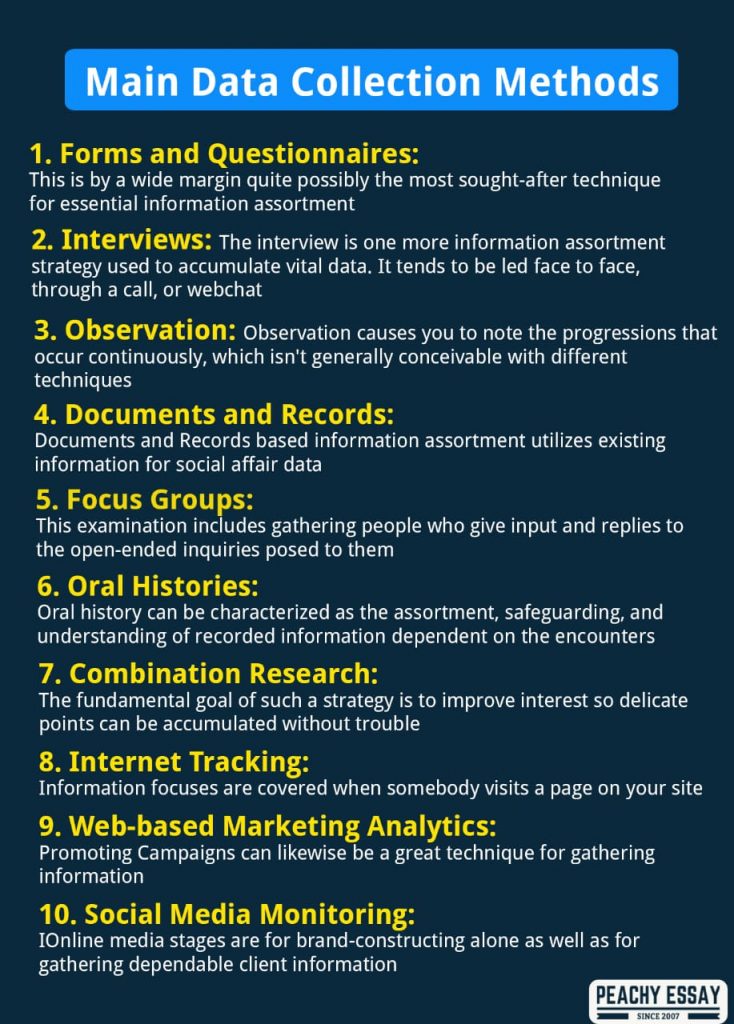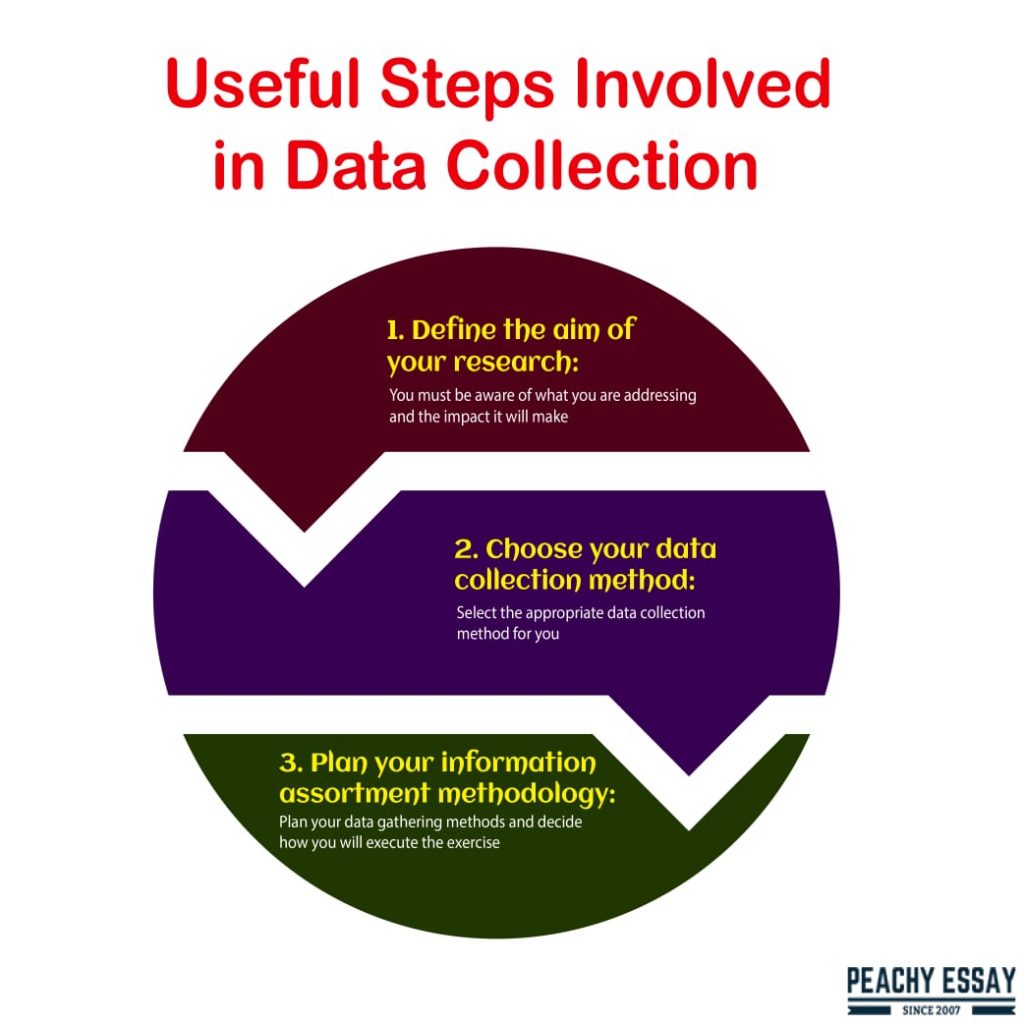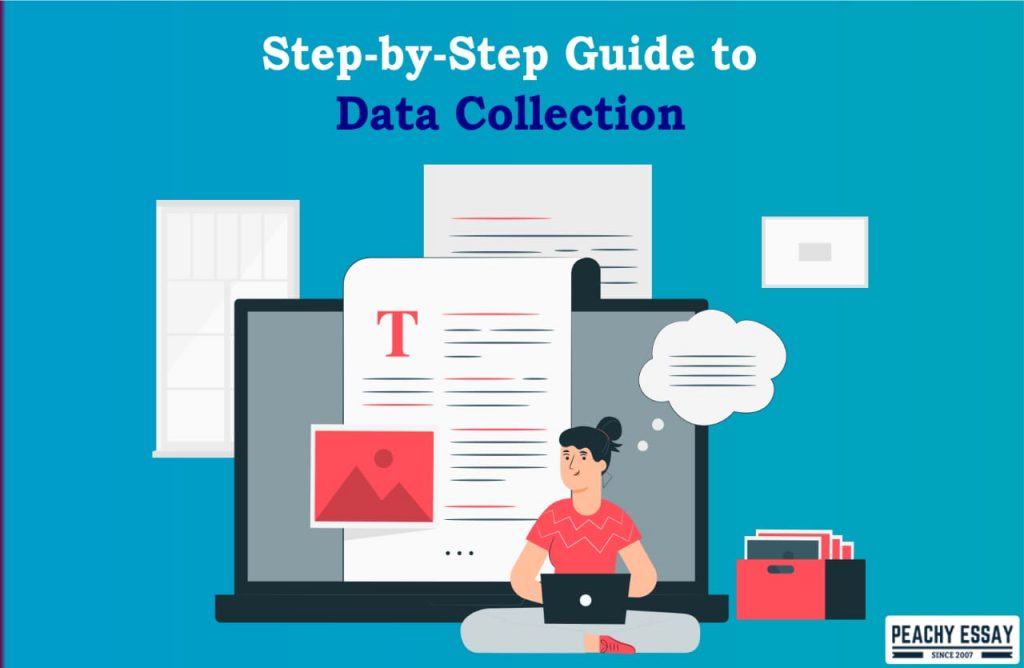When you have the correct data and the correct apparatuses to measure and dissect that information, you can transform that data into information and make more informed decisions. However, the information gathered ought to be significant, exact, and taken in setting, or probably it very well may be deluding, which can hurt a business.
In this guide, you will familiarize yourself with the steps in data collection, types of data collection, and data gathering methods.
What is Data Collection?
Data collection is the way of gathering and estimating data from different sources in a manner that empowers you to discover answers to real inquiries and to acquire new experiences that would not be promptly self-evident. For instance, the exact evaluation of gathered information can help you investigate the latest things and even anticipate future patterns.
What are the Advantages of Data Collection?
Here are the advantages of data collection.
- It causes you to focus your restricted effort and assets on the pieces that have the most effect.
- It helps you in understanding your clients better.
- It encourages you to examine drifts better regarding how client assessments and conduct change over the long haul.
- You can make faster, more compelling choices dependent on the information gathered.
- Feedback allows you to determine issues and improve your product/service where it’s generally required.
- It improves client connections.
What are the Different Types of Data Collection?
With regards to data collection, there are many valuable techniques. Before diving into the data collection techniques, there’s something you need to know. Data collection methods can be primary or secondary.
Primary Data Collection
Primary data gathering entails the collection of raw data for explicit exploration. Primary data collection strategies can be divided into two parts.
Qualitative Research Method
The qualitative exploration strategy essentially relies upon the non – measurable components like feelings, assessments, and sentiments. This technique doesn’t include any numbers or estimations at all. A fine illustration of a subjective information assortment technique would be open-ended guides like a review structure you convey to clients.
Quantitative Research Method
Unlike the qualitative data collection strategies, the quantitative technique relies upon numbers and numerical computations to help you conclude. Any closed-ended questions require calculated answers, similar to the ones including mean, middle, mode, and so on. An exemplary illustration of this kind of information assortment is a survey. You’re mostly inspired by the numbers they produce to arrive at your decisions/choices.
Read more: Quantitative vs. Qualitative Research
Secondary Data Collection
In simple terms, Secondary data collection happens when you gather information from an optional source as opposed to from the first one. This sort of information can be sourced from online entrances, books, and journals that have been now distributed. It is regularly the simpler and less expensive strategy when contrasted with essential information assortment.
Data Collection Methods
Since you know the diverse information assortment classifications, we should move to our article’s core, the main data collection methods.

- Forms and Questionnaires
This is by a wide margin quite possibly the most sought-after technique for essential information assortment, fundamentally because it’s so natural, adjustable, and amazing and permits secure information assortment from a wide client base with little exertion. This information assortment technique improves the exactness of information by and large because it is “organized” naturally. Such an information assortment strategy can be utilized to secure responses for close-ended inquiries productively and create many data and leads whenever planned appropriately.
You need to design out the inquiries cautiously. Ensure you incorporate pertinent, short inquiries in your forms that your audience can, without much of a stretch, comprehend. Assuming not, the odds are that your audience may feel separated and quit from reacting in the long run. Thus, if reaction rates and significant data are the things you need, ensure you connect with important information assortment structure.
If you are managing a huge crowd, electronic structures and polls become important instead of a pleasant-to-have. You will actually want to gather authoritative information from a huge audience surprisingly fast and at low cost, for instance, by showing the structure on a high-traffic site or connecting to it in a huge email crusade. Most programming sites with data collection forms have progressed highlights like auto-scaling in-assembled, so on the off chance that you have an unexpected spike in rush hour gridlock, you can seek help from them.
- Interviews
The interview is one more information assortment strategy used to accumulate vital data. It tends to be led face to face, through a call, or webchat.
Open-ended questionnaires are all the more regularly posted in interviews. You should know about the inquiries to be posed and shouldn’t bargain with quality and proficiency. Meetings can be a costly technique for information assortment, and you ought not to leave space for blunders.
The adaptability of meetings is one advantage that the questioner has. He/she can ask follow-up inquiries that relate to the past answers as the data trade happens progressively.
- Observation
With regards to observation, there are insignificant inquiries included. The data accumulated by the researcher can likewise be founded on the decisions they mention of the observable fact, yet it needn’t be one-sided consistently.
Observation causes you to note the progressions that occur continuously, which isn’t generally conceivable with different techniques. For example, you can see how the state of mind of your audience changes progressively.
Observation is one of the key information assortment techniques used to frame a theory. It isn’t generally feasible as it relies upon the circumstance, and one-sided results can be considered typical.
- Documents and Records
Documents and Records based information assortment utilizes existing information for social affair data.
This is an auxiliary information assortment strategy where you don’t need to invest energy investigating your own as a significant piece of the examination has been recorded.
You don’t need to have a list of inquiries as there is no such interest. Monetary and participation records are an illustration of this technique.
Depending on reports and records, it is also quite possibly the most financially savvy information assortment strategy; however, they are not as effective as their partners.
- Focus Groups
Focus Groups fall in the qualitative information assortment classification. This examination includes gathering people who give input and replies to the open-ended inquiries posed to them. Focus groups can be viewed as a mix of meetings, overviews, and perceptions.
The principal objective of such an information assortment strategy is to accumulate aggregate feelings instead of individual ones.
The coordinator can pose open-ended inquiries like ‘What was your number one component of the item’ or comparative inquiries. The gathering talks about among themselves and advances a common assessment.
- Oral Histories
As its name recommends, oral history can be characterized as the assortment, safeguarding, and understanding of recorded information dependent on the encounters and considerations of individuals who were essential for the specific occasion. Oral accounts are basically founded on a solitary phenomenon or occasion.
- Combination Research
Going under the essential information assortment classification, mix research is a mix of focus groups and interviews. The fundamental goal of such a strategy is to improve interest so delicate points can be accumulated without trouble.
Combination research secures the respondents’ obscurity, permitting them to give precise, impartial data, which improves the information’s lavishness.
- Internet Tracking
Did you realize that 40 distinctive information focuses are covered when somebody visits a page on your site? Indeed, they do, which is why web-based following can be extraordinary compared to other information assortment strategies for site proprietors.
The site facilitating supplier or even an examination programming can go about as your information assortment device and help you gather data about the two clients and prospects the same.
You can likewise utilize the track pixels and cookies to track your site guest’s activities throughout the span of various meetings.
- Web-based Marketing Analytics
Promoting Campaigns can likewise be a great technique for gathering information. You will gather significant data from the promoting efforts through pages, web-based media, messages, and so on. The product that you use to put the promotions in different objections can help you gather information.
The apparatus can disclose to you who tapped on your promotion, the number of clicks, how often it was clicked, what gadget it clicked, from what district you acquired the greatest snaps, etc.
Information can be gathered even from disconnected showcasing efforts also. For instance, a promotion on a means of transport can have a specific telephone number or short URL publicized, which is explicit to that disconnected mission; along these lines, your outreach group knows precisely where they started from.
- Social Media Monitoring
Today, every business has its quality in web-based media. Online media stages are for brand-constructing alone as well as for gathering dependable client information too.
You can get crucial information from different parts of online media. For example, you can gauge your clients’ commitment to your posts through the number of impressions, likes, offers, and remarks.
You can examine your devotees’ exercises, how they react to your page via web-based media, and even portion them as needs be.
What are the Steps in Data Collection?
Here are the steps involved in data collection:

Define the aim of your research:
Before you start data collection, you need to understand the aim of your research. You must be aware of what you are addressing and the impact it will make.
Choose your data collection method:
Select the appropriate data collection method for you. Here are some of the data collection methods you may use.
- Experimental research is fundamentally a quantitative method.
- Ethnography, interviews, and focus groups are qualitative strategies.
- Surveys, observation, documented research, and secondary data can be quantitative or qualitative approaches.
Plan your information assortment methodology:
Plan your data gathering methods and decide how you will execute the exercise.
Operationalization.
Convert abstract ideas into quantifiable operation terms. This will allow you to measure the variables.
Sampling:
You may have to build up an examining plan to acquire information methodically. This includes characterizing a populace, the group you will, in reality, gather information from.
Your testing technique will decide how you enlist members or acquire estimations for your investigation. To settle on an examining strategy, you should consider factors like the necessary example size, availability of the example, and the information assortment period.
Standardizing procedures:
If various researchers are included, compose a nitty-gritty manual to normalize data collection techniques in your examination.
This implies spreading out explicit bit by bit guidelines. Hence, everybody in your examination group reliably gathers information – for instance, by conducting tests under similar conditions and utilizing target rules to record and order perceptions.
This guarantees your information’s unwavering quality, and you can likewise utilize it to duplicate the examination later on.
Creating a data management plan:
Before starting data collection, you should likewise choose how you will arrange and store your information.
On the off chance that you gather information from individuals, you will probably have to anonymize and protect the information to forestall leaks of delicate data.
You should perform records or information section in precise manners to limit mutilation on the off chance that you are gathering information through meetings or pencil-and-paper designs.
You can forestall the loss of information by having an organization system that is regularly backed up.
Collect data
At long last, you can carry out your picked techniques to quantify or notice the factors you are keen on.
To guarantee that great information is recorded methodically, here are some prescribed procedures:
Record all significant data as and when you get information. For instance, note down whether or how lab hardware is recalibrated during a trial study.
Double-check manual data entry for mistakes.
If you gather quantitative information, you can survey the dependability and legitimacy to demonstrate your information quality.
Information Collection Integrity
How much defective information can hurt your data collection targets can be lopsidedly huge, contingent upon how your information is being utilized. Therefore, it is critical to maintaining a severe norm of information assortment integrity in exploring strategy and execution and handling.
The inadequately gathered information can:
- Compromise the conclusions drawn from research
- Undermine the capacity to rehash and test research
- Deceive leaders
- Cause damage to members, especially if protection is penetrated
- Distort processing
The most effective method to preserve data integrity:
A proactive position towards research honesty is needed to forestall issues around data collection. Responsive measures are costly and frequently expect exploration to be rehashed; safeguard measures guarantee information trustworthiness is imbued as a general system feature.
Issues around information respectability might be purposeful, for example, those found when directing in-field subjective examination, or unexpected, like the precise or irregular blunders when gathering and preparing information.
Researchers portray ‘quality confirmation’ and ‘quality control’ as two strategies that can ensure information honesty. From one perspective, quality confirmation focuses on exercises scientists or overseers can carry out before information assortment starts, for example, defining assortment measures. Then again, quality control refers to activities taken during or after the exploration has been led. A researcher ought to use the two methodologies while considering their information assortment plan.




